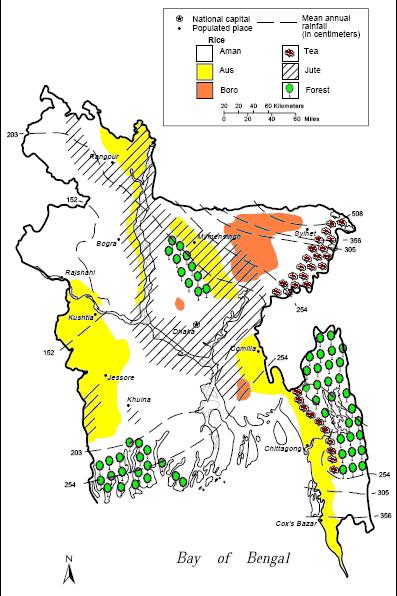Map

Map showing the growing areas of major agricultural products of Bangladesh.
Map Courtesy: Wikipedia
Info
Agriculture in Bangladesh
Bangladesh has a primarily agrarian economy. Agriculture is the single largest producing sector of the economy since it comprises about 18.6% (data released on November, 2010) of the country's GDP and employs around 45% of the total labor force. The performance of this sector has an overwhelming impact on major macroeconomic objectives like employment generation, poverty alleviation, human resources development and food security.
A plurality of Bangladeshis earn their living from agriculture. Although rice and jute are the primary crops, wheat is assuming greater importance. Tea is grown in the northeast. Because of Bangladesh's fertile soil and normally ample water supply, rice can be grown and harvested three times a year in many areas. Due to a number of factors, Bangladesh's labor-intensive agriculture has achieved steady increases in food grain production despite the often unfavorable weather conditions. These include better flood control and irrigation, a generally more efficient use of fertilizers, and the establishment of better distribution and rural credit networks. With 35.8 million metric tons produced in 2000, rice is Bangladesh's principal crop. National sales of the classes of insecticide used on rice, including granular carbofuran, synthetic pyrethroids, and malathion exceeded 13,000 tons of formulated product in 2003. The insecticides not only represent an environmental threat, but are a significant expenditure to poor rice farmers. The Bangladesh Rice Research Institute is working with various NGOs and international organizations to reduce insecticide use in rice.
In comparison to rice, wheat output in 1999 was 1.9 million metric tons. Population pressure continues to place a severe burden on productive capacity, creating a food deficit, especially of wheat. Foreign assistance and commercial imports fill the gap. Underemployment remains a serious problem, and a growing concern for Bangladesh's agricultural sector will be its ability to absorb additional manpower. Finding alternative sources of employment will continue to be a daunting problem for future governments, particularly with the increasing numbers of landless peasants who already account for about half the rural labor force.
Food crops
Although Rice, Wheat, Mango and jute are the primary crops, and rice and wheat are mostly main crops or food crops of some countries. Due to the expansion of irrigation networks, some wheat producers have switched to cultivation of maize which is used mostly as poultry feed. Tea is grown in the northeast. Because of Bangladesh's fertile soil and normally ample water supply, rice can be grown and harvested three times a year in many areas. Due to a number of factors, Bangladesh's labor-intensive agriculture has achieved steady increases in food grain production despite the often unfavorable weather conditions. These include better flood control and irrigation, a generally more efficient use of fertilizers, and the establishment of better distribution and rural credit networks. With 28.8 million metric tons produced in 2005-2006 (July–June), rice is Bangladesh's principal crop. By comparison, wheat output in 2005-2006 was 9 million metric tons. Population pressure continues to place a severe burden on productive capacity, creating a food deficit, especially of wheat. Foreign assistance and commercial imports fill the gap. Underemployment remains a serious problem, and a growing concern for Bangladesh's agricultural sector will be its ability to absorb additional manpower.
Source: Wikipedia.
